



Energy Costs Associated with Commercial Broiler Production
By G.T. Tabler, I.L. Berry and A.M. Mendenhall for the University of Arkansas's Avian Advice - Commercial broiler growers face a number of challenges associated with producing profitable broiler flocks. While unable to control all factors associated with broiler production, growers can control the key areas of temperature and ventilation, but maintaining adequate temperature and ventilation requires significant monetary expense.Introduction
Data recently compiled at the Applied Broiler Research Unit may be of value in assessing your farms’ energy demand and (based on your costs for fuel and electricity) monetary expense to meet this demand.
Housing and Management Practices
The information presented represents data from 38 consecutive flocks of straight run broiler chickens grown at the Applied Broiler Research Unit during the period October 1996 through June 2003. All flocks were grown for the same integrator under a standard broiler production contract.
The houses were all 40 x400 ft. Two houses (1 and 3) featured conventional cross-ventilation with low-pressure foggers, while the other two houses were curtain-sided and tunnel ventilated. One tunnel ventilated house (4) had evaporative cooling pads and the other (2) had an experimental
sprinkler system. Detailed descriptions of the houses, environmental control systems, sprinkler
system, and housing modifications was given by Berry et al. (1991), Xin et al. (1993) and Tabler and Berry (2001). Management practices were the same in all houses and the farm manger was the same individual throughout the study period. Half of the 38 flocks were grown for 49 days or less while the other half were grown for more than 49 days. The youngest flock was 39 days at harvest
while the oldest was harvested at 57 days.
Propane Usage
Figure 1 presents propane usage by house during the seven-year period. As evident by the graphs and as many growers will remember, the winter of 2000 was the most costly in terms of fuel usage followed by the winter of 2001. The lower fuel consumption in House 3 during the winters of 1998 and 1999 was due to use of an experimental wood-burning pellet furnace.
House 4 was the most challenging house to control from a management standpoint since it had more ammonia than any other house. This increased ammonia required increased ventilation to maintain the proper environment resulting in increased gas consumption during cooler periods of the year. Although House 4 consumed the most fuel during the seven-year period, it should be noted that when the 1998 and 1999 data were ignored, tunnel ventilated houses consumed only 2% more fuel than did
conventional houses. Also, if the ammonia problem in house 4 could be solved, tunnel ventilated houses would likely consume less fuel than conventional houses.
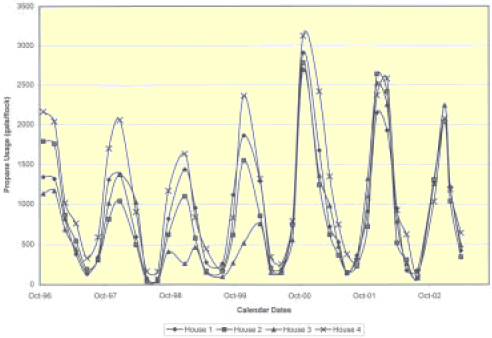
Table 1 lists the maximum, minimum and average fuel consumption per flock for each of the four houses. House 4 used the most fuel even during the summer flock when fuel usage was minimal. This was mainly associated with additional nighttime ventilation needed for ammonia control. Based onthe figures in Table 1, propane consumption for the farm over the seven-year period averaged 3,657 gallons per flock. If we assume 5.5 flocks per year then the four-house farm would have used 20,114 gallons of propane per year or 5,029 gallons per house per year. If propane costs $1.00 per gallon, it would cost over $20,000 for a year’s worth of propane. In view of these costs, growers may be tempted to reduce temperatures slightly. However, flock performance, and therefore, grower payment can be seriously affected if growers attempt to raise birds at temperatures cooler
in the winter. The data in Table 2 illustrate how decreased temperatures can increase flock mortality.
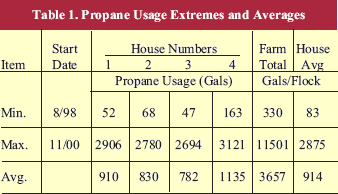 |
||
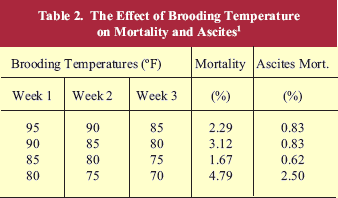 |
||
| 1From Deaton et al., 1996. | ||
Electricity Usage
Figure 2 presents electricity usage by house. As every grower knows, electricity usage was greatest in the summer months and lowest in the winter months. The summer of 2000 was the most costly in terms of electricity usage followed by the summer of 2001. However, unlike propane usage, each house accounted for an equal amount of electricity usage (25%) during the 7-year period. The increased electrical demand in House 3 during the winters of 1998 and 1999 are again associated with use of the wood-burning pellet furnace in that house. Table 3 lists maximum, minimum and average kilowatt hour (kWh) consumption per flock for each of the four houses.
Even though House 1 showed the highest kWh usage as compared to the other houses, there was less than 185 kWh difference between houses and the houses were the same when compared on a percentage-of-use basis. Electricity usage for the farm over the 7-yr period averaged 12,617 kWh per flock (Table 2). Based on 5.5 flocks per year the farm would have used 69,394 kWh per year or 17,348 kWh per house per year. If electricity costs $0.06 cents per kWh, electricity costs would come to $4,164 for the farm or $1041 per house.
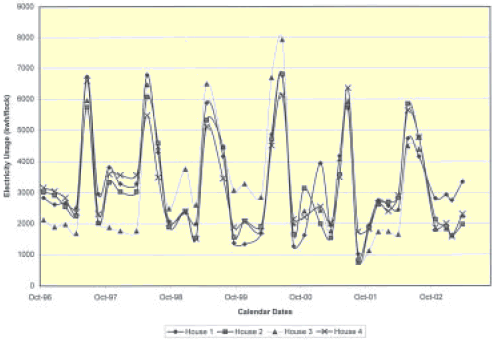
Total Energy Costs
Energy costs (fuel and electricity) consume approximately 25% of the annual gross farm income at the Applied Broiler Energy Unit. Propane and electricity usage for the farm are presented together in Figure 3 and, as expected, indicates that the two consumption curves are essentially inverse functions of one another, representing the high demand for heating in the winter and cooling in the summer. However, because fuel costs are much greater than electricity, growers have a much more serious problem dealing with high fuel bills in the winter than they do the electric bill in the summer.
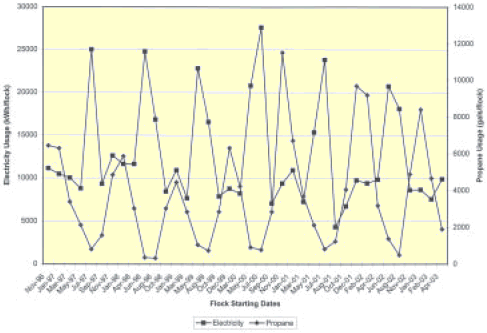
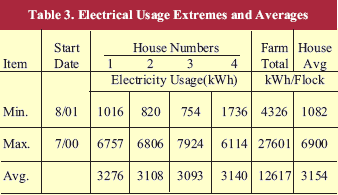
Summary
Contract growers face numerous challenges associated with raising broilers. One significant challenge is the monetary expense related to fuel and electricity costs. Energy data from 38 consecutive flocks of straight run broilers over a seven-year period at the Applied Broiler Energy Unit indicate that approximately 25% of the gross farm income is required to pay the annual propane and electricity bills and that propane costs may be roughly four to five times the cost of electricity. While energy costs will vary somewhat from farm-to-farm, the wise use of energy should be a priority for all growers.
References
Berry, I. L., R. C. Benz, and H. Xin. 1991. A controller for combining natural and mechanical ventilation of broilers. Paper No. 914038. Amer. Society of Ag. Engineers, St. Joseph, MI.
Deaton, J. W., S. L. Branton, J. D. Simmons and B. D. Lott. 1996. The effect of brooding
temperature on broiler performance. Poultry Science 75:1217-1220.
Tabler, G. T., and I. L. Berry. 2001. Applied broiler research unit report: Ten-year summary of
broiler production results. Report prepared for Ark. Farm Bureau Young Farmers and Ranchers
Conference. Hot Springs, AR. August 3-4.
Xin, H., I. L. Berry, T. L. Barton, and G. T. Tabler. 1993. Sidewall effects on energy use in broiler houses. J. Appl. Poult. Res.2:176-183.
Xin, H., I. L. Berry, T. L. Barton, and G. T. Tabler. 1994. Feed and water consumption, growth, and mortality of male broilers. J. Poult Sci.73:610-616.

Source: Avian Advice - Winter 2003 - Volume 5, Number 4








